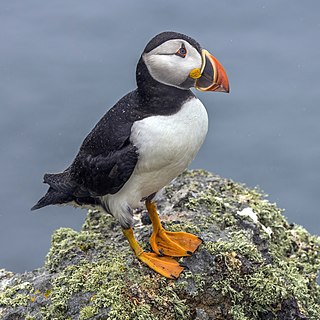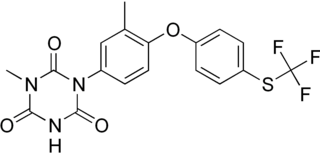
The tufted puffin, also known as crested puffin, is a relatively abundant medium-sized pelagic seabird in the auk family (Alcidae) found throughout the North Pacific Ocean. It is one of three species of puffin that make up the genus Fratercula and is easily recognizable by its thick red bill and yellow tufts.

Puffins are any of three species of small alcids (auks) in the bird genus Fratercula. These are pelagic seabirds that feed primarily by diving in the water. They breed in large colonies on coastal cliffs or offshore islands, nesting in crevices among rocks or in burrows in the soil. Two species, the tufted puffin and horned puffin, are found in the North Pacific Ocean, while the Atlantic puffin is found in the North Atlantic Ocean.

Auks or alcids are birds of the family Alcidae in the order Charadriiformes. The alcid family includes the murres, guillemots, auklets, puffins, and murrelets. The family contains 25 extant or recently extinct species that are divided into 11 genera. Auks are found throughout the Northern Hemisphere.

The Atlantic puffin, also known as the common puffin, is a species of seabird in the auk family. It is the only puffin native to the Atlantic Ocean; two related species, the tufted puffin and the horned puffin being found in the northeastern Pacific. The Atlantic puffin breeds in Russia, Iceland, Ireland, Britain, Norway, Greenland, Newfoundland and Labrador, Nova Scotia, and the Faroe Islands, and as far south as Maine in the west and France in the east. It is most commonly found in the Westman Islands, Iceland. Although it has a large population and a wide range, the species has declined rapidly, at least in parts of its range, resulting in it being rated as vulnerable by the IUCN. On land, it has the typical upright stance of an auk. At sea, it swims on the surface and feeds on zooplankton, small fish, and crabs, which it catches by diving underwater, using its wings for propulsion.

Bempton Cliffs is a section of precipitous coast at Bempton in the East Riding of Yorkshire, England. It is run by the RSPB as a nature reserve and is known for its breeding seabirds, including northern gannet, Atlantic puffin, razorbill, common guillemot, black-legged kittiwake and fulmar. There is a visitor centre.

Coccidia (Coccidiasina) are a subclass of microscopic, spore-forming, single-celled obligate intracellular parasites belonging to the apicomplexan class Conoidasida. As obligate intracellular parasites, they must live and reproduce within an animal cell. Coccidian parasites infect the intestinal tracts of animals, and are the largest group of apicomplexan protozoa.
Coccidiosis is a parasitic disease of the intestinal tract of animals caused by coccidian protozoa. The disease spreads from one animal to another by contact with infected feces or ingestion of infected tissue. Diarrhea, which may become bloody in severe cases, is the primary symptom. Most animals infected with coccidia are asymptomatic, but young or immunocompromised animals may suffer severe symptoms and death.
Eimeria acervulina is a species of Eimeria that causes coccidiosis in poultry worldwide. Affected birds tend to appear depressed with reduced appetite, diarrhea, and depigmentation. Diagnosis is made by necropsy based on lesions in the upper third of the small intestine, and the appearance of white or grey striations along the intestinal mucosa. Scrapings of the mucosa from diseased birds can reveal oocysts.

Eimeria is a genus of apicomplexan parasites that includes various species capable of causing the disease coccidiosis in animals such as cattle, poultry and smaller ruminants including sheep and goats. Eimeria species are considered to be monoxenous because the life cycle is completed within a single host, and stenoxenous because they tend to be host specific, although a number of exceptions have been identified. Species of this genus infect a wide variety of hosts. Thirty-one species are known to occur in bats (Chiroptera), two in turtles, and 130 named species infect fish. Two species infect seals. Five species infect llamas and alpacas: E. alpacae, E. ivitaensis, E. lamae, E. macusaniensis, and E. punonensis. A number of species infect rodents, including E. couesii, E. kinsellai, E. palustris, E. ojastii and E. oryzomysi. Others infect poultry, rabbits and cattle. For full species list, see below.
Eimeria stiedae is a species of Eimeria that causes hepatic coccidiosis in rabbits. It was observed for the first time by Antonie van Leeuwenhoek in 1674.
Eimeria necatrix is a species of Eimeria that causes very severe intestinal coccidiosis in older poultry characterized by congestion, hemorrhage, necrosis of the intestine and bloody feces. Very large schizonts can be seen as white or yellow dots and oocysts can be found occasionally in the ceca.
Eimeria brunetti is a species of Eimeria that causes hemorrhagic intestinal coccidiosis in poultry worldwide. Lesions are limited to lower small intestine.

Toltrazuril is an antiparasitic medication used primarily to treat coccidiosis in animals. Coccidiosis is a parasitic disease caused by coccidia, which are microscopic, spore-forming, single-celled obligate intracellular parasites belonging to the apicomplexan class Conoidasida.
Dow's puffin is an extinct seabird in the auk family described in 2000 from subfossil remains found in the Channel Islands of California. It was approximately as large as the modern horned puffin and its beak appeared to have been an intermediate between the rhinoceros auklet and the horned puffin. It lived during the Late Pleistocene and Early Pleistocene on the Channel Islands, where it nested alongside the ancient murrelet, Cassin's auklet and Chendytes lawi.
Arctica was an ancient continent that formed in the Neoarchean era.
Eimeria zuernii is a species of the parasite Eimeria that causes diarrheic disease known as eimeriosis in cattle, and mainly affects younger animals. The disease is also commonly referred to as coccidiosis. The parasite can be found in cattle around the globe.
Eimeria arlongi is a species of Eimeria that causes clinical coccidiosis in goats. It and Eimeria ninakohlyakimovae are two of the most pathogenic species for goats. It is particularly prevalent in goat kids in Iran. Issues with coccidiosis specifically due to Eimeria arloingi have also been reported in Egypt and Portugal. It is unclear whether this species is present in the Americas as most of the case reports of coccidiosis in these areas do not differentiate the species causing the disease. Infections with this species are commonly compounded by infections with other Eimeria species in "mixed infections." This species is closely related to Eimeria bovis and Eimeria zuernii which are both highly pathogenic in cattle' Infections with this species are characterized by lesions specifically in the jejunum, but also the ilium and cecum which results in diarrhea. Oocysts begin shedding between 16 and 18 days after the animal is infected which is when the parasite is spread. The shedding can last as long as 15 days. This parasite causes an immune response in its host that includes accumulation of fluid in body cavities, presence of large numbers of leukocytes in the small intestine, and necrosis of the tissue of the small intestine. Pale yellow plaques can be seen on the small intestine of severely affected kids at necropsy.

The Turbot Bank is a shelf bank and mound feature of the seabed of the North Sea that lies off the east coast of Scotland, about 44 kilometres (27 mi) east of Peterhead. The depth of water above the bank varies from 60 m below sea level on top of the bank down to 80 m at its margins. It has been designated as a Nature Conservation Marine Protected Area since 2014.
Eimeria bovis is a parasite belonging to the genus Eimeria and is found globally. The pathogen can cause a diarrheic disease in cattle referred to as either eimeriosis or coccidiosis. The infection predominantly cause disease in younger animals.
Eimeria falciformis is an obligate intracellular parasite that primarily infects the mouse species Mus musculus. As part of the Apicomplexa phylum, it has a complex life cycle within its host, causing tissue necrosis and inflammation, particularly in the cecum. This leads to coccidiosis, a disease characterized by symptoms like diarrhoea and weight loss. E. falciformis is one of over 1,700 species in the Eimeria genus, which infects the intestinal epithelial cells of various animals, including poultry and livestock.








